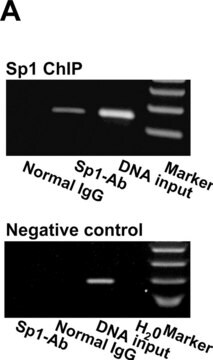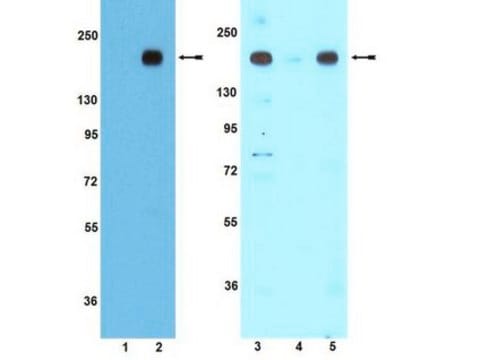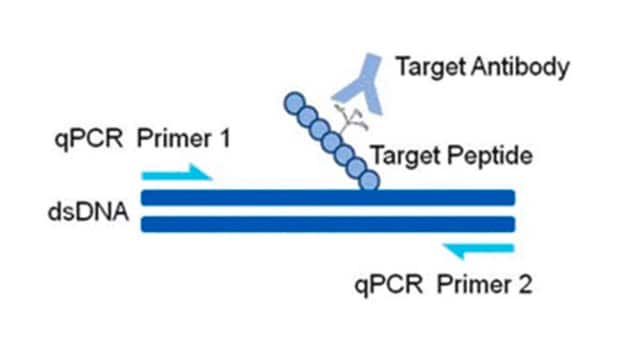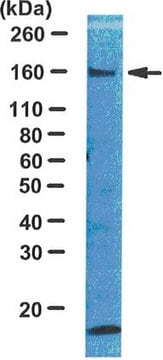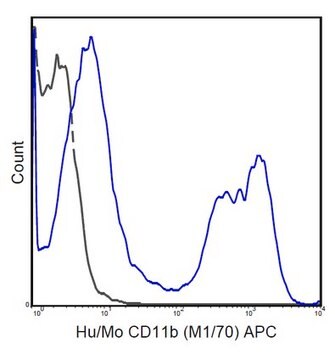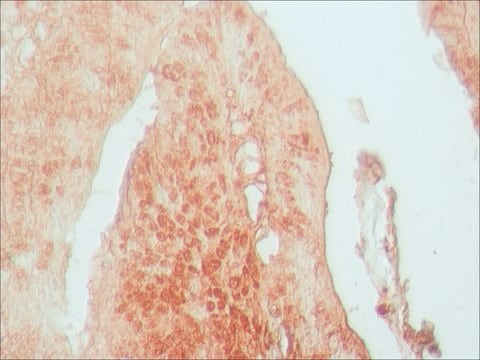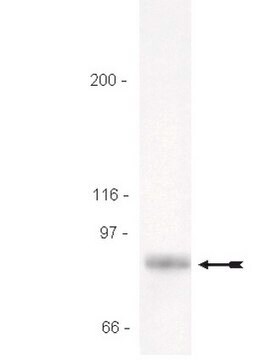17-601
ChIPAb+ Sp1 - ChIP Validated Antibody and Primer Set
from rabbit
Synonym(s):
Transcription factor Sp1, TSFP1
Sign Into View Organizational & Contract Pricing
All Photos(2)
About This Item
UNSPSC Code:
12352203
eCl@ss:
32160702
NACRES:
NA.41
Recommended Products
biological source
rabbit
Quality Level
clone
polyclonal
species reactivity
rat, human, mouse
manufacturer/tradename
ChIPAb+
Upstate®
technique(s)
ChIP: suitable
western blot: suitable
NCBI accession no.
UniProt accession no.
shipped in
dry ice
General description
Every lot of the ChIPAb+ line of antibodies is individually validated for chromatin precipitation, in order to guarantee successful ChIP assays every time. Each antibody includes a control primer set for performance confirmation. Sp1 antibody and the negative control antibody (rabbit normal IgG) can be used to demonstrate that the Sp1 antibody is functionally validated in the precipitation of Sp1 associated chromatin.
The qPCR primers included flank the Sp1 binding site in human DHFR promoter.
The qPCR primers included flank the Sp1 binding site in human DHFR promoter.
Transcription factor SP1 can activate or repress transcription in response to physiological and pathological stimuli. Binds with high affinity to GC-rich motifs and regulates the expression of a large number of genes involved in a variety of processes such as cell growth, apoptosis, differentiation and immune responses. Highly regulated by post-translational modifications (phosphorylations, sumoylation, proteolytic cleavage, glycosylation and acetylation). Binds also the PDGFR-alpha G-box promoter. May have a role in modulating the cellular response to DNA damage. Implicated in chromatin remodeling. Plays a role in the recruitment of SMARCA4/BRG1 on the c-FOS promoter. Plays an essential role in the regulation of FE65 gene expression. In complex with ATF7IP, maintains telomerase activity in cancer cells by inducing TERT and TERC gene expression. Isoform 3 is a stronger activator of transcription than isoform 1. Positively regulates the transcription of the core clock component ARNTL/BMAL1.
Specificity
Sp1
Immunogen
Full length human Sp1 protein
Application
Research Category
Epigenetics & Nuclear Function
Epigenetics & Nuclear Function
Research Sub Category
Chromatin Biology
Chromatin Biology
SP1 ChIP validated antibody & primer set including the ChIP-grade antibody & the specific control PCR primers used for chromatin immunoprecipitation of SP1.
Western Blot Analysis:
HeLa nuclear extract was resolved by electrophoresis, transferred to nitrocellulose and probed with anti-Sp1 (0.2 μg/mL). Proteins were visualized using a goat anti-rabbit secondary antibody conjugated to HRP and a chemiluminescence detection system (Please see figures).
HeLa nuclear extract was resolved by electrophoresis, transferred to nitrocellulose and probed with anti-Sp1 (0.2 μg/mL). Proteins were visualized using a goat anti-rabbit secondary antibody conjugated to HRP and a chemiluminescence detection system (Please see figures).
Packaging
25 assays per kit, ~4μg per chromatin immunoprecipitation.
Quality
Chromatin immunoprecipitation:
Sonicated chromatin prepared from 1 x 106 HeLa cells was subjected to chromatin immunoprecipitation using 4 μg of either the negative control antibody, Rabbit Normal IgG or Rabbit Anti-Sp1 and the Magna ChIPTM A kit (Cat.# 17-610) Rapid Protocol (2 hour IP). Successful enrichment of Sp1 associated DNA fragments was verified by qPCR using ChIP Primers DHFR flanking the human DHFR promoter that contains a Sp1 binding site (Please see figures).
Please refer to the EZ-Magna ChIP A (Cat.# 17-408)
or EZ-ChIP (Cat.# 17-371) kit protocols for
experimental details.
Sonicated chromatin prepared from 1 x 106 HeLa cells was subjected to chromatin immunoprecipitation using 4 μg of either the negative control antibody, Rabbit Normal IgG or Rabbit Anti-Sp1 and the Magna ChIPTM A kit (Cat.# 17-610) Rapid Protocol (2 hour IP). Successful enrichment of Sp1 associated DNA fragments was verified by qPCR using ChIP Primers DHFR flanking the human DHFR promoter that contains a Sp1 binding site (Please see figures).
Please refer to the EZ-Magna ChIP A (Cat.# 17-408)
or EZ-ChIP (Cat.# 17-371) kit protocols for
experimental details.
Target description
105 kDa and 95 kDa
Physical form
Anti-Sp1 (Rabbit polyclonal IgG). 1 vial containing 100 μg of protein A purified IgG in 100 μL of 0.014 M phosphate buffer, pH 7.6, 0.175 M NaCl, 0.07% sodium azide and 30% glycerol. Store at -20°C. The Sp1 antibody is made against full length human Sp1 protein and can recognize Sp1, MW 105 kDa and 95 kDa, of human, mouse and rat origins.
Normal Rabbit IgG. One vial containing 125 μg of normal rabbit IgG in 125 μL. Store at -20°C.
ChIP primers DHFR. 1 vial containing 75 μL of 5 μM of each control primer specific for human dihydrofolate reductase (DHFR) promoter. Store at -20°C.
FOR: TCG CCT GCA CAA ATA GGG AC
REV: AGA ACG CGC GGT CAA GTT T
Normal Rabbit IgG. One vial containing 125 μg of normal rabbit IgG in 125 μL. Store at -20°C.
ChIP primers DHFR. 1 vial containing 75 μL of 5 μM of each control primer specific for human dihydrofolate reductase (DHFR) promoter. Store at -20°C.
FOR: TCG CCT GCA CAA ATA GGG AC
REV: AGA ACG CGC GGT CAA GTT T
Format: Purified
Protein A purified
Storage and Stability
1 year at -20°C from date of shipment.
Analysis Note
Control
Includes negative control rabbit IgG and control primers specific for human dihydrofolate reductase (DHFR) promoter.
Includes negative control rabbit IgG and control primers specific for human dihydrofolate reductase (DHFR) promoter.
Legal Information
UPSTATE is a registered trademark of Merck KGaA, Darmstadt, Germany
Disclaimer
Unless otherwise stated in our catalog or other company documentation accompanying the product(s), our products are intended for research use only and are not to be used for any other purpose, which includes but is not limited to, unauthorized commercial uses, in vitro diagnostic uses, ex vivo or in vivo therapeutic uses or any type of consumption or application to humans or animals.
Storage Class Code
10 - Combustible liquids
Certificates of Analysis (COA)
Search for Certificates of Analysis (COA) by entering the products Lot/Batch Number. Lot and Batch Numbers can be found on a product’s label following the words ‘Lot’ or ‘Batch’.
Already Own This Product?
Find documentation for the products that you have recently purchased in the Document Library.
Paulisally Hau Yi Lo et al.
PloS one, 8(4), e61279-e61279 (2013-04-18)
Hepatitis C virus (HCV) infection is the major cause of hepatocellular carcinoma (HCC) in Japan. We previously identified the association of SNP rs2596542 in the 5' flanking region of the MHC class I polypeptide-related sequence A (MICA) gene with the
Ziling Huang et al.
Oncology reports, 34(5), 2403-2412 (2015-09-10)
Long non-coding RNA (lncRNA) metastasis-associated lung adenocarcinoma transcript 1 (MALAT1), also known as nuclear-enriched transcript 2 (NEAT2), is highly conserved among mammals and highly expressed in the nucleus. It was first identified in lung cancer as a prognostic marker for
Epigenetic up-regulation of leukemia inhibitory factor (LIF) gene during the progression to breast cancer.
Shin, JE; Park, SH; Jang, YK
Molecules and Cells null
Yuanyuan Zhao et al.
Molecular oncology, 12(3), 305-321 (2017-12-08)
Transforming growth factor-beta (TGF-β) functions as a potent proliferation inhibitor and apoptosis inducer in the early stages of breast cancer, yet promotes cancer aggressiveness in the advanced stages. The dual effect of TGF-β on cancer development is known as TGF-β
Sylvain Fauquenoy et al.
Scientific reports, 7, 43221-43221 (2017-03-04)
Human T-lymphotropic Virus type 1 (HTLV-1) infection is characterized by viral latency in the majority of infected cells and by the absence of viremia. These features are thought to be due to the repression of viral sense transcription in vivo.
Our team of scientists has experience in all areas of research including Life Science, Material Science, Chemical Synthesis, Chromatography, Analytical and many others.
Contact Technical Service